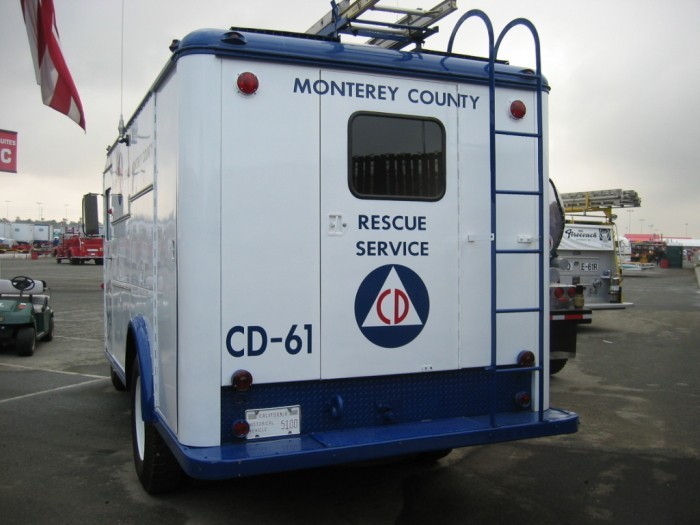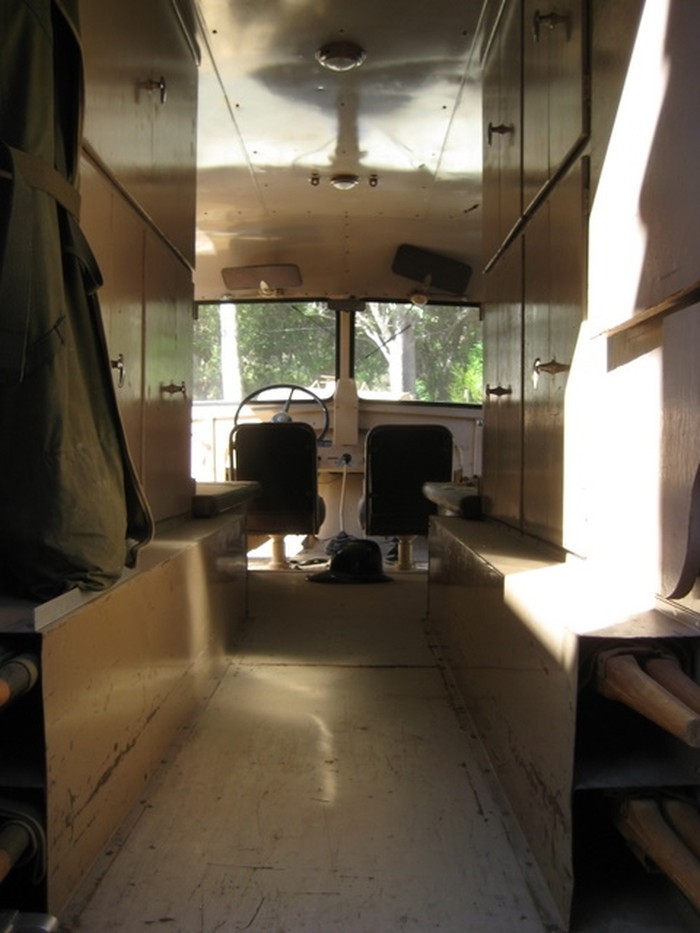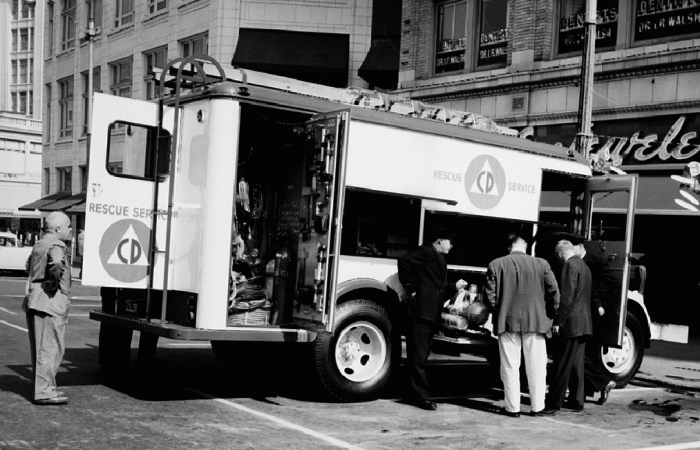Calamity Jane – a heavy-duty heroine for the nuclear age
Posted on Aug 26, 2022 in Featured | 2 comments

For those of us raised in the United States from the 1950s into the 1990s, the ever-present threat of nuclear war was acknowledged, but not necessarily dwelled upon. Fallout shelter signs were a common sight in cities and towns alike, and most municipalities had their own Civil Defense department, marked with the instantly recognizable blue circle, white triangle and red CD letters. Thanks to a federal grant program kicked off in the early 1950s, many also had “Calamity Janes,” heavy rescue trucks from manufacturers like REO, International and GMC. These Calamity Janes are now little more than a footnote to history, but it’s worth making sure that they aren’t forgotten.
Civil Defense programs first began in the United States during World War I, but were implemented in a more widespread and organized manner during World War II, especially in coastal areas. Civilian volunteers monitored the skies and the seas for signs of an enemy invasion that, thankfully, never came. The end of the war brought with it a temporary reduction in Civil Defense activities, but this was to be short-lived.

On August 29, 1949, the USSR detonated its first atomic bomb, and though no one could know it at the time, the Cold War was on. The Federal Civil Defense Act of 1950 laid the groundwork for modern Civil Defense planning, accepting the harsh reality that an exchange of nuclear weapons would bring with it devastating consequences. Planning began for bomb shelters and fallout shelters, mass casualty medical treatment, fire control, debris cleanup, mass evacuations, relocation of essential industries, economic rehabilitation and federal government continuity. At the state level, civil defense plans were formed for municipalities, while education on what to do during a nuclear attack (“Duck and Cover”) began at the elementary school level.
Realizing that recovery from a nuclear attack would take resources that most municipalities lacked, the federal government developed a grant program for cities to purchase rescue vehicles from manufacturers like Willys, GMC, International, and REO. Divided into Light Duty (gross vehicle weight up to 10,000 pounds), Medium Duty (gross vehicle weight between 10,000 and 20,000 pounds) and Heavy Duty (gross vehicle weight over 20,000 pounds) categories, the government ordered roughly 1,300 vehicles for Civil Defense purposes.

All heavy rescue trucks, whether from REO, International or GMC, were known as “Calamity Janes,” though it isn’t clear how this nickname came about. Upon delivery, each was finished in a white with blue livery, labeled with the familiar Civil Defense logo and the words “Rescue Service.” Cities and towns receiving Calamity Janes were later able to purchase them, reportedly for very little money, with the understanding that they would continue to provide disaster support for neighboring communities for a one-year period. Departments were also allowed to repaint the trucks, as long as the Civil Defense logos remained prominent.
While the Calamity Janes were large trucks, the inventory that each rig carried must have required some extremely creative packing. Per a 1974 Civil Defense publication, the standard list for each heavy-duty vehicle included five self-contained breathing apparatus plus one reserve tank; two 8-pound flat head axes; two 36” wrecking bars; two 66” crowbars; two 88” crowbars; two asbestos protective blankets; 12 blankets; eight pairs pullover rubber boots; one tool box; six 14-quart galvanized buckets; two five-gallon safety cans of gasoline; one 10’ 5,000-pound capacity chain; two debris buckets; one five-gallon drinking water container; eight flameproof coveralls; six 100’ 10-gauge extension cords; three extension cord reels; two junction boxes with six outlets each; two 110v three-prong adapters; two 2.5 gallon pump-type fire extinguishers; one 1.5-ton lifting tackle; eight pairs heavy-duty gloves; two pairs protective gloves; two pairs insulating rubber gloves (rated at 10,000 volts); eight sets dust-proof and shatterproof goggles; one four-pound sledge hammer; two eight-pound sledge hammers; two 16-pound sledge hammers; eight luminescent safety helmets; two five-ton jacks; two 10-ton jacks; two 20-ton jacks; two 36-unit first aid kits; eight sling-type first aid kits; one 12-foot roof ladder with folding hooks; one 24-foot, two-section extension ladder; one 10’ folding ladder; eight battery-powered hand lights; one life gun kit; one cutting torch outfit; two each pick, point and chisel; one 6’ pike pole; one 10’ pike pole; two 2,500 watt gasoline-powered generators; four 250 watt portable flood lights; four 500-watt portable flood lights; 1,200’ of ½” manila rope, cut in defined lengths; 1,200’ of ¾” manila rope, cut in defined lengths; one 24-inch gasoline-powered chainsaw with extra chain; one crosscut saw, 4.4” blade; one heavy-duty Sawzall kit; one portable power saw with two each wood, steel and masonry blades; eight rubber sheets, 84” x45”; two long-handle pointed shovels; two D-handle square-mouth shovels; two short tunneling shovels; four Army-type folding stretchers; two basket-type stretchers (Stokes litters); 20 assorted tackle blocks, in 4” and 6” sizes; one wire rope snatch block to fit winch cable; three 12’x14’ tarpaulins; one hand tool kit; one mobile two-way radio; and one portable resuscitator inhaler.

A Calamity Jane in service in Seattle, circa 1956. Photo courtesy Seattle Municipal Archives.
Though not specified in the 1974 literature, it’s also likely that each Calamity Jane carried Geiger counters and other radiological measuring devices, unless these were carried in other Civil Defense vehicles. Each heavy-duty rig also featured a front bumper-mounted tripod and winch assembly, and from period photographs it appears that these were affixed only when needed for a particular task.
The custom-built bodies incorporated designs borrowed from British and European Civil Defense agencies, and reportedly could be rearranged to serve as military-style ambulances in the event of a mass casualty event. Offloading the various bits of gear to rearrange the interior would have been a time-consuming process, so it’s unlikely that many Calamity Janes ever saw service as ambulances.

Photo courtesy Seattle Municipal Archives.
Thankfully, none of the Calamity Janes were ever used in a worst-case nuclear disaster role, though many saw action in the aftermath of natural disasters. Given how long the trucks remained in service (in back-up support roles, into the 1990s), photos of the Calamity Janes in action are surprisingly rare. While some have been repurposed or restored, it isn’t clear how many remain today, or even how many heavy-duty trucks were supplied by each manufacturer.





.gif)


there is one these trucks sitting in field outside of Plymouth ,Ohio
Might make a cool rig for ham radio emergency communications.
Radio club I belong to once had an old Civil Defense gas powered generator. 1500 watts with a 2 quart gas tank. Had to fill it up every 2 hours.
Huge monstrosity, we had mounted it on a trailer. Rope pull start. Noisy as all heck.
Today we use 2000 watt portable Honda generators that are extremely quiet and run at least 18 hours on one tank while operating two or three 100 watt radios.